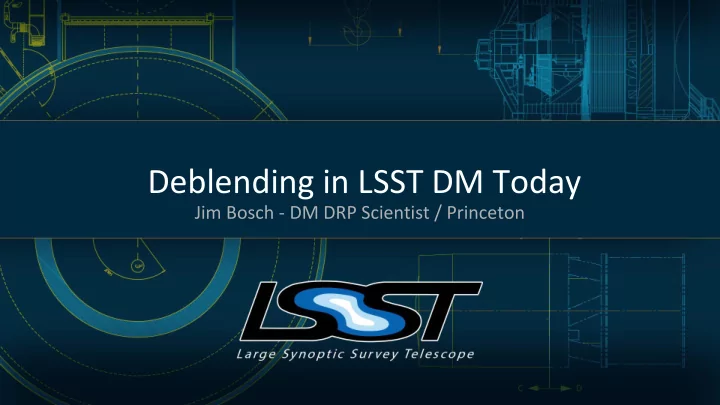

Deblending in LSST DM Today Jim Bosch - DM DRP Scientist / Princeton
Images to Catalogs in Four Steps Inspired by the SDSS Photo Pipeline, the DM Pipelines decomposes the process of generating a catalog from an image into four steps: ● Detection ● Association ● Deblending ● Measurement This is not the only decomposition of the problem, and it's probably not the best one for certain science analyses. It's just one that worked well for SDSS (and to a lesser extent, HSC). 2
Four Steps 1. Detect: find above-threshold footprints and peaks in all images. 2. Associate: merge footprints and peaks into a single consistent set. 3. Deblend: apportion flux to each peak, generating children. 4. Measure: run algorithms on child pixels. 3
Four Steps 1. Detect: find above-threshold footprints and peaks in all images. 2. Associate: merge footprints and peaks into a single consistent set. 3. Deblend: apportion flux to each peak, generating children. 4. Measure: run algorithms on child pixels. 4
Four Steps 1. Detect: find above-threshold footprints and peaks in all images. 2. Associate: merge footprints and peaks into a single consistent set. 3. Deblend: apportion flux to each peak, generating children. 4. Measure: run algorithms on child pixels. 5
Four Steps 1. Detect: find above-threshold footprints and peaks in all images. 2. Associate: merge footprints and peaks into a single consistent set. 3. Deblend: apportion flux to each peak, generating children. 4. Measure: run algorithms on child pixels. 6
Reusing the Four Steps The Four Steps are mid-level reusable algorithms ("Tasks"), and we use each of them in slightly different ways in different parts of the pipelines, as we produce several different catalogs: ● Source (single-epoch direct image processing) ● DIASource (single-epoch difference image processing) ● Object (multi-epoch/coadd direct image processing) ● DIAObject/SSObject (multi-epoch difference image processing) ● ForcedSource (single-epoch forced photometry) 7
Data Release Production (Future)
Data Release Production (Today)
Alert Production Association Alert Generation
Where Deblending Happens Detection, Deblending, Measurement (only one image at a time, so no association)
Where Deblending Happens Detection, Deblending, Measurement Association into DIAObjects happens after Deblending and Measurement
Where Deblending Happens Detection, Association, Deblending, Measurement
Where Deblending Happens (Partial) Deblending and Measurement only.
Problems with the Four Steps ● Doesn't work in crowded stellar fields: need to subtract bright stars before trying to detect faint stars. ● Doesn't work around bright galaxies: wings push noise peaks above detection threshold. ● Measurement errors don't account for uncertainty in deblending. 15 15
The SDSS Deblender (in 1-d) a) True profiles (unknown). b) Construct a symmetric template for each peak by taking the maximum of the pixels on opposite sides. c) Jointly fit (linear least squares) amplitudes for all templates in the blend, and reapportion pixel values based on the fractional contribution of each template to each pixel. d) Residuals. 16
The SDSS Deblender (in 2-d) Much more likely to have a pristine pixel on one side in 2-d. Three-in-a-row alignments are still a problem, but they were rare enough in SDSS not to be a major problem. 17
The SDSS Deblender: Heuristics ● If a template looks like the PSF model, use the PSF model instead. ● Don't permit templates to have unphysically sharp features. ● If two templates are very similar (defined by their dot product), drop one of them. ● Assign "stray flux" using 1/r 2 law. 18
The LSST Deblender: Heuristics ● If a template looks like the PSF model, use the PSF model instead. ● Don't permit templates to have unphysically sharp features. ● If two templates are very similar (defined by their dot product), drop one of them. ● Assign "stray flux" using 1/r 2 law. 19
Deblender Status The LSST reimplementation of the SDSS deblender has worked well enough for HSC to do some great science, but it's also the single biggest problem in the quality of our outputs. ● Many more blends, and many more three-in-a-row cases, especially in crowded regions (e.g. galaxy clusters), and those can lead to catastrophic deblending. ● Faint detections on the outskirts of large objects steal flux from larger neighbors. 20
Measuring Deblended Objects In order to measure a deblended object, we: 1. Replace all above-threshold regions with random noise generated to match that of the background. 2. Insert the deblended pixels for the target object back into the image. 3. Run the suite of measurement algorithms. This assigns flux outside above-threshold regions to all sources instead of assigning it to none. 21
Summary ● "Deblender" means something very specific in the pipeline right now: given above-threshold regions and peaks, generated deblended peaks. It doesn't have to always mean that. ● We run the deblender in several places in the pipelines, and each time it has a slightly different relationship to the steps before and after it. ● We're currently using a reimplementation of the SDSS deblender, but at (coadded) LSST depths, it doesn't work nearly as well as it did for SDSS: the problem is simply much harder. 22
Recommend
More recommend